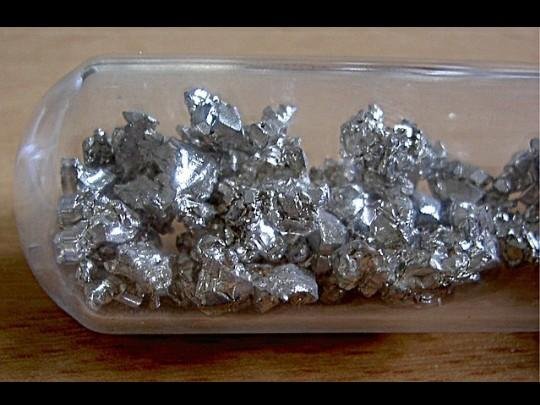Calcium
Calcium is a chemical element with symbol Ca and atomic number 20. An alkaline earth metal, calcium is a reactive pale yellow metal that forms a dark oxide-nitride layer when exposed to air. Its physical and chemical properties are most similar to its heavier homologues strontium and barium. It is the fifth most abundant element in Earth's crust and the third most abundant metal, after iron and aluminium. The most common calcium compound on Earth is calcium carbonate, found in limestone and the fossilised remnants of early sea life; gypsum, anhydrite, fluorite, and apatite are also sources of calcium.
Calcium, 20Ca
General properties
Pronunciation /ˈkælsiəm/
KAL-see-əm
Appearance dull gray, silver; with a pale yellow tint[1]
Standard atomic weight (Ar, std) 40.078(4)[2]
Calcium in the periodic table
Hydrogen
Helium
Lithium
Beryllium
Boron
Carbon
Nitrogen
Oxygen
Fluorine
Neon
Sodium
Magnesium
Aluminium
Silicon
Phosphorus
Sulfur
Chlorine
Argon
Potassium
Calcium
Scandium
Titanium
Vanadium
Chromium
Manganese
Iron
Cobalt
Nickel
Copper
Zinc
Gallium
Germanium
Arsenic
Selenium
Bromine
Krypton
Rubidium
Strontium
Yttrium
Zirconium
Niobium
Molybdenum
Technetium
Ruthenium
Rhodium
Palladium
Silver
Cadmium
Indium
Tin
Antimony
Tellurium
Iodine
Xenon
Caesium
Barium
Lanthanum
Cerium
Praseodymium
Neodymium
Promethium
Samarium
Europium
Gadolinium
Terbium
Dysprosium
Holmium
Erbium
Thulium
Ytterbium
Lutetium
Hafnium
Tantalum
Tungsten
Rhenium
Osmium
Iridium
Platinum
Gold
Mercury (element)
Thallium
Lead
Bismuth
Polonium
Astatine
Radon
Francium
Radium
Actinium
Thorium
Protactinium
Uranium
Neptunium
Plutonium
Americium
Curium
Berkelium
Californium
Einsteinium
Fermium
Mendelevium
Nobelium
Lawrencium
Rutherfordium
Dubnium
Seaborgium
Bohrium
Hassium
Meitnerium
Darmstadtium
Roentgenium
Copernicium
Nihonium
Flerovium
Moscovium
Livermorium
Tennessine
Oganesson
Mg
↑
Ca
↓
Sr
potassium ← calcium → scandium
Atomic number (Z) 20
Group, period group 2 (alkaline earth metals), period 4
Block s-block
Element category alkaline earth metal
Electron configuration [Ar] 4s2
Electrons per shell
2, 8, 8, 2
Physical properties
Phase (at STP) solid
Melting point 1115 K (842 °C, 1548 °F)
Boiling point 1757 K (1484 °C, 2703 °F)
Density (near r.t.) 1.55 g/cm3
when liquid (at m.p.) 1.378 g/cm3
Heat of fusion 8.54 kJ/mol
Heat of vaporisation 154.7 kJ/mol
Molar heat capacity 25.929 J/(mol·K)
Vapour pressure
P (Pa) 1 10 100 1 k 10 k 100 k
at T (K) 864 956 1071 1227 1443 1755
Atomic properties
Oxidation states +2, +1[3] (a strongly basic oxide)
Electronegativity Pauling scale: 1.00
Ionisation energies
1st: 589.8 kJ/mol
2nd: 1145.4 kJ/mol
3rd: 4912.4 kJ/mol
(more)
Atomic radius empirical: 197 pm
Covalent radius 176±10 pm
Van der Waals radius 231 pm
Spectral lines
Miscellanea
Crystal structure face-centred cubic (fcc)
Speed of sound thin rod 3810 m/s (at 20 °C)
Thermal expansion 22.3 µm/(m·K) (at 25 °C)
Thermal conductivity 201 W/(m·K)
Electrical resistivity 33.6 nΩ·m (at 20 °C)
Magnetic ordering diamagnetic
Magnetic susceptibility +40.0·10−6 cm3/mol[4]
Young's modulus 20 GPa
Shear modulus 7.4 GPa
Bulk modulus 17 GPa
Poisson ratio 0.31
Mohs hardness 1.75
Brinell hardness 170–416 MPa
CAS Number 7440-70-2
History
Discovery and first isolation Humphry Davy (1808)
Main isotopes of calcium
Isotope Abundance Half-life (t1/2) Decay mode Product
40Ca 96.941% stable
41Ca trace 1.03×105 y ε 41K
42Ca 0.647% stable
43Ca 0.135% stable
44Ca 2.086% stable
45Ca syn 162.7 d β− 45Sc
46Ca 0.004% stable
47Ca syn 4.5 d β− 47Sc
γ –
48Ca 0.187% 6.4×1019 y β−β− 48Ti 
nice post vote for vote ok friends